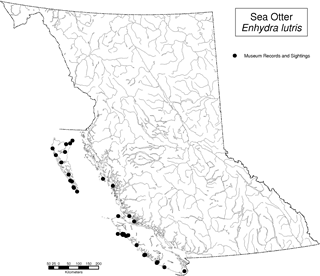Historically, the Sea Otter was found across the North Pacific, from Japan to peninsular and south coastal Alaska and south to Baja California, Mexico (Kenyon 1969). (IUCN 2011). However, as a result of commercial harvesting this species was almost extirpated throughout its entire range. Today, with reintroductions, populations are found from the Aleutian Islands in Alaska south to California, but with gaps in its distribution where populations have not recovered (IUCN 2011).
|
In British Columbia, Sea Otters were reintroduced following extirpation by the fur trade. "Between 1969 and 1972, 89 Sea Otters were flown or shipped from Alaska to the west coast of Vancouver Island, British Columbia. They established a healthy population, estimated to be over 3,000 as of 2004, and their range is now from Tofino to Cape Scott. In 1989, a separate colony was discovered in the central British Columbia coast. It is not known if this colony, which had a size of about 300 animals in 2004, was founded by transplanted otters or by survivors of the fur trade." (IUCN 2011).
|
|
